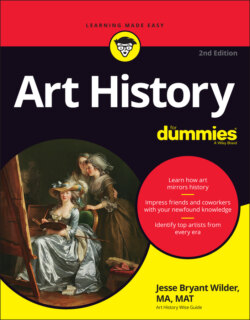Читать книгу Art History For Dummies - Jesse Bryant Wilder - Страница 123
Mingling with the Minoans: Snake Goddesses, Minotaurs, and Bull Jumpers
ОглавлениеAegean culture (civilization around the Aegean Sea) didn’t begin with the Greeks — it started with the Minoans in the late third millennium BC. The Minoans lived on the island of Crete (south of what became the Greek mainland). Crete is about 160 miles long and 37 miles wide (at its widest). Though they traded with the Egyptians and Mesopotamians, the Minoans lived in relative isolation and developed a unique culture. Their art focused not on death and war like the Egyptians and Mesopotamians, but on life, beauty, and partying!
The Minoans are named after the mythical King Minos who supposedly ruled Crete and owned a half-man, half-bull “pet” called the Minotaur. The pet’s name is a variant of the king’s because the Minotaur was also his stepson. Minos’s wife cheated on him with a bull! Minos penned up his monstrous stepson in a labyrinth and sacrificed young Athenian men and women to him until the mythical Athenian hero Theseus slew the beast.
Actually, the Minoans were a peaceful people. They made more tools than weapons, and their chief god was not a thunderbolt-wielding macho man like Zeus, but a sexy-looking snake-goddess. Her cult animals (animals associated with worship) included the dove, snake, and bull. The Minotaur myth probably evolved from the Minoans’ infamous religious sport, bull jumping, in which young men and women somersaulted off the backs of wild bulls.
The Minoans built palaces (though much less impressive than Egyptian and Mesopotamian palaces), which they decorated with elaborate murals. In fact, mural paintings were their greatest cultural achievement. The Toreador Fresco (circa 1500 BC), which features the bull-jumping event, is the most dramatic example (see Figure 7-1).
Notice that the women vaulters (in front of and behind the bull) are white skinned, suggesting that they spent more time indoors than the dark-skinned male jumper. Yet we see total sexual equality here. Man and woman are equal partners in this dangerous but playful religious sport. In fact, the women outnumber the men in the fresco.
The streamlined bodies in The Toreador Fresco brim with exuberant life. Even the bull’s S-shaped tail looks like a wisp of playful energy. Here is a breakdown of other aspects of the Minoan art style:
Harmony and sequential action: The wavelike shapes of bull and jumper harmonize, suggesting that man and nature are one in Crete. The next jumper stands anxiously on her tiptoes, ready to vault off the bull’s back, while an earlier jumper holds the bull’s horns. (Obviously, there was some fictionalizing here!) The positions of the three jumpers suggest the sequence of actions involved in bull jumping.
Fluidity: Compare the graceful Minoan shapes that seem to flow like waves with the sturdy-as-a-mountain forms of Egyptian art (see Chapter 6) and Mesopotamian art (see Chapter 5). The latter two were both river-based cultures, hemmed in by deserts. The Minoans were the first civilization to be surrounded by sea. The tides of the Aegean seem to wash refreshingly through the Minoans’ art and culture.
Exuberance: If art reflects the people who make it, the Minoans must’ve been a fun-loving folk. Their murals feature diving dolphins, creepy-crawly octopi, lovely and lively floral landscapes, and wavelike patterns inspired by the sea. A Minoan palace looked a bit like an indoor SeaWorld. But perhaps their culture was too fun loving and easygoing to survive in a brutal world.
rostislavv / 123 RF
FIGURE 7-1: The Minoans didn’t run with the bulls like they do in Pamplona; they somersaulted off their backs, as shown in The Toreador Fresco from Knossos, Crete.
In about 1500 BC, aggressive Greek tribes invaded Crete and established the first Greek culture. Gradually, the Greeks fanned out over the Peloponnese peninsula and Aegean Islands. But the conquered Minoans didn’t disappear completely. They merged with the Greeks, creating what we call Mycenaean culture. The Mycenaeans probably invented the colorful Greek myths that have been handed down to us, and they launched the Trojan War, which is recounted in the greatest epic poem ever written, The Iliad.
After the Trojan War, Mycenaean culture collapsed, falling to another wave of invading Greek tribes called the Dorians, who settled in Sparta and the Peloponnesian peninsula. The Ionian Greeks, who’d migrated centuries earlier, were entrenched in Athens and surrounding Attica, where they had resided since the era of the mythical Theseus and the Minoans.
After the fall of Mycenae, several centuries of squabbling passed before Greece settled into what became classical Greece, a constellation of far-flung city-states from Asia Minor and the Greek mainland to Sicily and the Mediterranean coast of France. Although a common language and culture united the Greek states, they were often at war with each other. For about 400 years after the conquest of Mycenae, the Greeks produced no significant art; they were too busy fighting. In the calmer eighth century BC, the first buds of Greek culture sprang up in the visual arts and literature. The Iliad and The Odyssey were created in the eighth and seventh centuries BC, initially as oral poems (imagine reciting 24 books from memory!).
